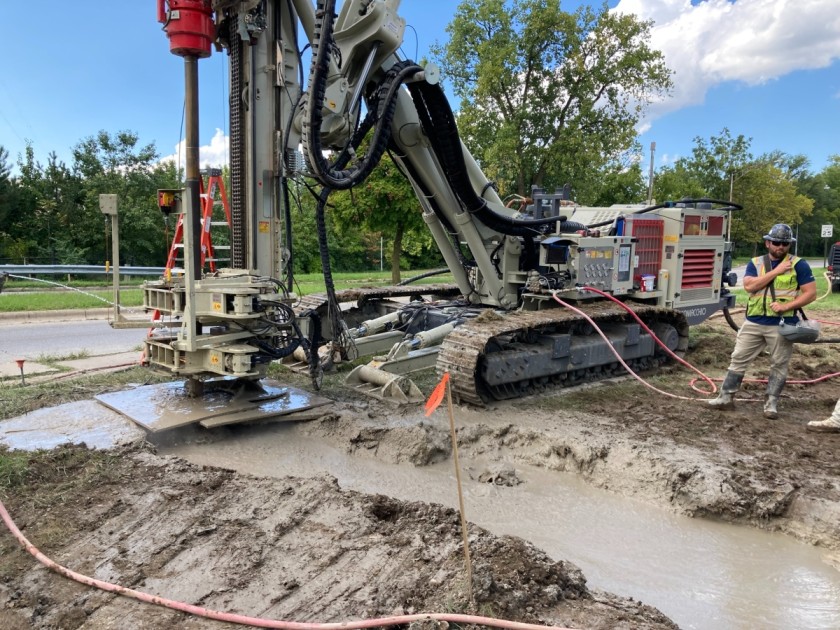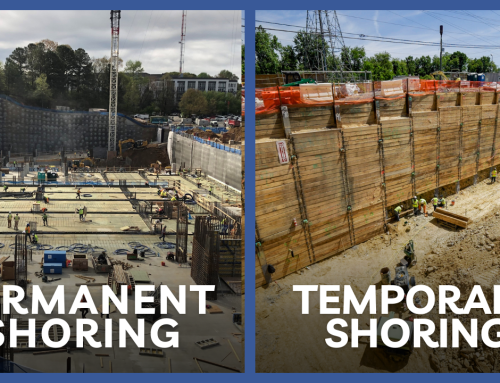Jet grouting is a ground improvement method used in construction to increase strength and reduce permeability of soil in-situ. The jet grout process involves injecting a high-velocity stream of cement grout in-situ into the soil under high pressure. The grout mixes with the soil, forming a cement-stabilized soil column. The resulting column enhances the ground’s strength, permeability, and load-bearing capacity, making it suitable for various construction purposes. The process can be adjusted to achieve different column shapes and sizes, depending on the project’s needs. This article will discuss jet grouting’s process, applications, advantages, limitations, and equipment used.
Contents
- How does Jet Grouting Work?
- Applications of Jet Grouting
- Advantages of Jet Grouting
- The Jet Grouting Process
- Jet Grouting Techniques
- Case Studies: Successful Jet Grouting Projects
- Future Developments
- Jet Grouting from Schnabel
- Conclusion
How Does Jet Grouting Work?
The jet grouting process begins with the drilling of a small-diameter borehole (70 to 120 mm) into the ground to the desired depth. The drill bit used to drill the borehole is equipped with nozzles on the side that allow high-pressure cement grout to be injected into the soil at high velocities. As the grout stream exits the nozzles, the drill stem is rotated and the cement grout erodes the surrounding soil and mixes with it, creating a soil-cement circular column. The resulting column’s size and strength depend on various factors, including grout composition, jet pressure, and withdrawal rate. The factors affecting the column size and strength are all monitored and recorded with specialized equipment.
Applications of Jet Grouting
Jet grouting can be applied in a wide range of construction projects. Some common applications include:
- Foundation Support: Jet grouting can be used to improve the bearing capacity of weak or loose soils, providing a stable foundation for buildings, bridges, and other structures.
- Underpinning: It can be used to underpin and stabilize the foundations of existing structures.
- Groundwater Seepage Control: Jet grouting is effective in reducing water seepage in dam foundations, levees, and underground structures.
- Soil Containment: It can create soil-cement cutoff walls to prevent contaminant migration in the ground.
- Slope Stabilization: Jet grouting is employed to stabilize slopes and prevent landslides in hilly terrains.
- Tunneling and Shaft Support: It can reinforce the soil around excavations, facilitating the construction of large and small diameter tunnels and shafts.
Advantages of Jet Grouting
Jet grouting offers several advantages over traditional ground improvement techniques:
- Versatility: It can be applied to various soil types and ground conditions, making it suitable for a wide range of projects.
- Minimal Disruption: Jet grouting operations can be done with smaller equipment that produces minimal vibrations, causing less disruption to the surrounding environment and structures.
- Enhanced Bearing Capacity: The resulting soil-cement columns significantly improve the ground’s load-bearing capacity, allowing for heavier construction loads.
- Real-Time Adjustments: The process can be adjusted in real-time to achieve the desired column shape and size, providing more control over the ground improvement process.
- Providing a Groundwater Cut-Off Under Obstructions and Utilities: By eroding the ground using a small diameter drill hole, the area beneath obstructions and utilities can be treated to provide a groundwater cut-off and improved strength.
The Jet Grouting Process
Jet grouting is a process that involves several key stages:
- Pre-Grouting Site Inspection: Before starting the jet grouting process, a thorough site inspection is conducted to understand the soil composition, strength, and permeability. This data helps determine the appropriate grout composition, jet pressure, and spacing between columns.
- Pre-Construction Test Program: A pre-construction test program is usually conducted by drilling a few test columns to ensure that the required column diameters and jet grout strengths can be achieved.
- Jet Grouting Execution: The actual jet grouting process begins with the drilling of boreholes to the desired depth. High-pressure cement grout is then injected into the ground while the drill bit is slowly withdrawn. The number and arrangement of boreholes depend on the project’s requirements.
- Production Monitoring: During the jet grouting process, monitoring and testing are essential to assess the effectiveness of the soil-cement columns. Various tests are conducted to measure the column’s strength, permeability, and overall performance.
Jet Grouting Techniques
Several types of jet grouting techniques and equipment are available, depending on the project requirements:
- Single Fluid Jet Grouting: Single fluid grouting involves using a single grout material to form jet grout columns. The grout used in this process typically consists of cementitious materials mixed with water and additives to achieve the desired properties. The grout is injected into the target area under pressure, and it sets and hardens over time, effectively stabilizing the soil or structure.
- Double Fluid Jet Grouting: Double fluid grouting involves the use of two separate components that are mixed at the point of injection. The first component is usually a mixture of cement and water (grout), while the second component is compressed air.
- Triple Fluid Jet Grouting: Triple fluid jet grouting involves the use of air and water through one nozzle and grout through a second nozzle. The triple fluid jet grout process results in the formation of soil-cement columns with larger diameters compared to conventional jet grouting methods.
Case Studies: Successful Jet Grouting Projects
- Ohio Canal Interceptor Tunnel (OCIT) (Akron, OH): Schnabel performed jet grouting for the OCIT project to facilitate the launch of a Tunnel Boring Machine (TBM). A 50’ x 40’ x 40’ deep jet grout block was installed which served as the starting block for the TBM. More information about this project can be found here. Additional information about this project’s impact on the city of Akron can be found here.
- J Avenue Water Treatment Plant (Cedar Rapids, IA): To install a water cutoff wall in close proximity to a 2-story concrete holding tank, Schnabel installed 67 jet grout columns. The wall of jet grout columns was successful in retaining the soil and water behind the wall. More information about this project can be found here.
Future Developments
As technology advances, we can expect further refinements and innovations in jet grouting techniques. Future developments may include improved grout compositions, enhanced equipment, and more sustainable grouting materials.
Jet Grouting From Schnabel
As a leading jet grouting contractor in the United States with over 60 years of experience, Schnabel takes pride in its expertise to provide innovative jet grouting solutions for groundwater control and foundation support. If your project requires innovative solutions to meet construction goals, Schnabel’s team is well-prepared to offer customized services to meet your project’s unique needs. Using jet grouting, Schnabel can enhance the durability, stability, and longevity of underground structures, ensuring optimal performance while guarding against potential risks.
Conclusion
Jet grouting is a powerful and versatile ground improvement technique used in construction projects. Its ability to stabilize and strengthen various soil types makes it a valuable tool for construction and infrastructure development. With ongoing advancements, jet grouting will continue to play a crucial role in enhancing the performance and longevity of various structures.






